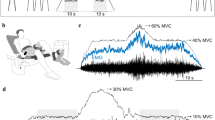Abstract
The relationship between maximal velocity and load was studied in nine muscles of the cat’s hind limb using a technique in which the initial and final muscle lengths are determined by equilibrium of a suspended mass and the muscle’s passive and active forces elicited by tetanic stimulation. The maximal veloities of shortening during contraction under each of various loads was used to fit a Hill model using the least-squares method. It was shown that different muscles varied significantly in their ability to generate maximal velocity over a range of loads. The tibialis anterior muscle generate the highest velocity (28·4 cms−1), whereas the tibialis posterior generated the lowest maximal velocity (4·2 cms−1). In general, muscles with predominantly fast twitch fibres and with the largest elongation/shortening range displaced the load at the highest velocities, as compared with muscles with predominantly slow twitch and short excursion range which respond with low velocities. The a/P0 ratio of Hill’s equation, which defines the curvature of the force velocity, also varied widely, being most monotonic (0·927) for the soleus and the steepest (0·067) for the extesor digitorum longus, further suggesting that fibre composition is also highly influential on the force—velocity relations of the muscle.
Similar content being viewed by others
References
Abbot, B. C., andWilkie, D. R. (1953): ‘The relation between velocity of shortening and the tension—length curve of skeletal muscle’,J. Physiol.,120, pp. 214–223
Ariano, M. A., Armstrong, R. B., andEdgerton, V. R. (1973): ‘Hindlimb muscle fiber populations of five mammals,’J. Histochem. Cytochem.,21, pp. 51–55
Baratta, R., Zhou, B.-H., andSolomonow, M. (1989): ‘Frequency response model of skeletal muscle: effect of perturbation level and control strategy,Med. Biol. Eng. Comput.,27, pp. 337–345
Baratta, R. V., andSolomonow, M. (1990): ‘The dynamic response model of nine different skeletal muscles,’IEEE Trans. Biomed. Eng.,37, pp. 243–251
Baratta, R., andSolomonow, M. (1991): ‘Dynamic performance of a load-moving skeletal muscle’,J. Appl. Physiol.,71, pp. 749–757
Baratta, R. V., andSolomonow, M. (1991): ‘The effect of tendon stiffness on the dynami performance of isometric muscle’,J. Biomech.,24, pp. 109–116
Baratta, R., andSolomonow, M. (1992): ‘The dynamic performance model of skeletal muscle,Crit. Rev. Biomed. Eng.,19, pp. 419–454
Baratta, R. V., Solomonow, M., Best, R., andD’Ambrosia, R. (1993): ‘The isotonic length—force models of nine different skeletal muscles’,Med. Biol. Eng. Comput.,31, pp. 449–458
Blix, M. (1891): ‘Die Lange und die Spannung des Muskels,’Skand, Arch. Physiol.,3, pp. 295–318
Claflin, D. R., andFaulkner, J. A. (1989): ‘The force—velocity relationship at high shortening velocities in the soleus muscle of the rat,’J. Physiol.,411, pp. 627–637
Close, R. I. (1972): ‘Dyamic properties of mammalian skeletal muscles,’Physiol. Rev.,52, pp. 129–197
Fenn, W. D., andMarsh, B. S. (1935): ‘Muscular force at different speeds of shortening,’S. Physiol.,85, pp. 277–297
Gareis, H., Solomonow, M., Baratta, R. V., Best, R., andD’Ambrosia, R. (1992): ‘Isometric length—force models of nine different skeletal muscles’,J. Biomech.,25, pp. 903–916
Guyton, A. C. (1986) ‘Textbook of medical physiology’ (W. B. Saunders, Philadelphia, PA)
Hatze, H. (1981): ‘Myocybernetic control models of skeletal muscle,’ University of South Africa, Pretoria
Hill, A. V. (1938): ‘The heat of shortening and the dynamic constants of muscle,’Proc. Roy. Soc. London,126B, pp. 136–195
Huijing, P. A. (1985): ‘Architecture of human gastrocnemius muscle and some functional consequences,’Acta. Anat.,123, pp. 101–107
Huijing, P. A., Van Lookeren-Campagne, A. A. H. andKoper, J. F. (1988): ‘Muscle architecture and fiber characteristics of rat gastrocnemius and semimembranosus during contraction,Acta. Anat.,135, pp. 46–52.
Kralj, A., andBajd, T. (1989): ‘Functional electrical stimulation for standing and walking,’ (CRC Press, Boca-Raton, Fl)
Marsolais, B., andEdwards, B. (1988): ‘Energy cost of walking and standing with functional electrical stimulation and long leg braces,’Arch. Phys. Med. Rehab.,69, pp. 243–249
Peckham, H., andKeith, M. (1992): ‘Motor prostheses for restoration of upper extremity function,’in Stein, R., Peckham, H., andPopovic, D. (Eds.): ‘Neural prostheses’ (Oxford Press, NY)
Ranatunga, K. W., andThomas, P. E. (1990): ‘Correlation between shortening velocity, force—velocity relation and histochemical fiber type composition in rat muscles’,J. Muscle Res. Cell. Motil.,11, pp. 240–250
Roeleveld, K., Baratta, R., Solomonow, M., VanSoest, A. G., andHuijing, P. (1993): ‘Role of tendon properties on the dynamic performance of different isometric muscles,’J. Appl. Physiol.,74, pp. 1348–1355
Roeleveld, K., Baratta, R., Solomonow, M., Huijing, P. (1994) ‘Role of tendon in the dynamic performance of three load moving muscles,’Ann. Biomed. Eng.,22, pp. 682–691
Solomonow, M. (1984): ‘External control of the neuromuscular system,’IEEE Trans. Biomed. Eng.,31, pp. 752–763
Solomonow, M. (1992): ‘Biomechanics and physiology of a practical functional neuromuscular stimulation powered walking orthosis for paraplegics,’in Stein, R., Peckham, H., Popovic, D., (Eds.): ‘Neural prostheses’ (Oxford Press, NY)
Spector, S. A., Gardiner, P. F., Zernicke, R. F., Roy, R. R. andEdgerton, V. R. (1980): ‘Muscle architecture and force—velocity characteristics of cat soleus and medial gastrocnemius: implications for motor control,’J. Neurophysical.,44, pp. 951–960
Vance, T., Solomonow, M., Baratta, R., Best, R., andD’Abrosia, R. (1994): ‘Comparison of isometric and constant load length tension models of two different muscles,’IEEE Trans. Biomed. Eng.,41, pp. 771–781
Walmsley, B., Hodgson, J., andBurke, R. (1978): ‘Forces produced by medial gastrocnemius and soleus muscles during locomotion in freely moving cats,’J. Neurophysiol.,41, pp. 1203–1216
Wilkie, D. R. (1956): ‘The mechanical properties of muscle’,Br. Med. Bull.,12, pp. 177–182
Woittiez, L. D., Huijing, P. A., andRozendal, R. H. (1983): ‘Influence of muscl architecture on the length—force diagram,’Pflügers Arch.,397, pp. 73–74
Young, R. P., Scott, S. H., Lloeb, G. E. (1992): ‘An intrinsic mechanism to stabilize positive-joint angle dependent moment arms of the feline ankle muscles,’Nerosc. Lett.,145, pp. 137–140
Zhou, B.-H., Baratta, R. V., Solomonow, M. (1987): ‘Manipulation of muscle force with various firing rate and recruitment control strategies,’IEEE Trans. Biomed. Eng.,34, pp. 128–139
Author information
Authors and Affiliations
Rights and permissions
About this article
Cite this article
Baratta, R.V., Solomonow, M., Best, R. et al. Force—velocity relations of nine load-moving skeletal muscles. Med. Biol. Eng. Comput. 33, 537–544 (1995). https://doi.org/10.1007/BF02522511
Received:
Accepted:
Issue Date:
DOI: https://doi.org/10.1007/BF02522511




